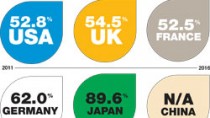Global DSP Sociomantic Labs Tames RTB for E-Commerce Marketers
Berlin-based Sociomantic Labs hit the U.S. in a big way last month with the hire of Jason Kelly, Admeld’s former chief revenue officer, as its new CEO (AdExchanger story). The company positions itself as a “performance DSP” with an e-commerce focus, competing with the likes of Criteo and traditional demand side platforms. It has global scale, with operations in Berlin, Warsaw, Paris, Amsterdam, São Paulo, Moscow, and New York — and is profitable, having accepted no funding.
AdExchanger kicked off this interview with Kelly and Sociomantic founder Thomas Brandhoff by discussing the weather, which was rainy in Berlin — where Brandhoff was calling from. More specifically, we talked about the weather’s impact on e-commerce and RTB.
Is there an increase in e-commerce transactions when the weather is bad?
THOMAS BRANDHOFF: Oh definitely, yes. There’s a direct correlation. But the data in combination with the IP data is pretty hard to handle so we haven’t included that into our algorithms yet.
Is there a follow on impact on RTB then and programmatic buying? More inventory?
Oh, absolutely. You can see, in general, more user activity on all kinds of advertiser platforms that we work with and therefore the transaction volume immediately rises, as well. Q4, Q1 are supposed to be the strongest quarters of the year. The complete business year and yes, we can easily think of 50 percent to 80 percent increase in budget spend for our eCommerce advertisers that we predominately work with.
What problem does Sociomantic Labs solve?
It was about four years ago that we founded the company — my fellow partners and I, Tom Nicolai, Lars Kirchhoff. What we had in mind was to build underlying database infrastructure that is faster than any ready‑made product that you can buy from the shelf. It was quite an uncompromising approach, taking us two years since we wanted to become simply faster than anybody else.
The problem that we address is that we deliver sales to our advertisers. That is, their picture of incremental transactions, ideally from traffic trends that they couldn’t make use of before. It is all about delivering incremental sales.
Is it appropriate to call Sociomantic a Demand Side Platform?
It is, definitely, for several reasons. We have thought about it, OK, are we…often we are comparison to working with a lot of first party data, from an advertiser point of view we are often put into the same market as, for example, companies like Criteo. However, given the perspective on our technology stack, given our transparent pricing and given the exclusive use of RTB inventory, we’d compare ourselves much more to a DSP as you would know it, from the U.S. American positioning stand point.
Who do you compete with most? Traditional DSPs?
At the moment, we definitely compete with companies like Criteo. In the medium term, I’d say the only competitors we will truly face are companies that have developed a full technology stack that is exclusively dedicated to real time bidding. If you don’t have this focus…we believe that you will not be capable of handling such high volumes of data on a global scale and that you will automatically lose competitiveness.
JASON KELLY: If you look at some of the traditional DSP’s within the U.S. market such as Invite, MediaMath, Turn, no doubt there is some degree of overlap in terms of what they are doing from a pure performance, e-commerce, retail [standpoint]. But they are also very much as upper funnel as they can get around display, mobile, video, branding budgets, those types of multiplatform buys. While we do a little bit of overlap within that DSP category, we’re much more of a performance DSP. We don’t really have a category that fits between what a MediaMath or Invite does across all platforms, and then what a Criteo is doing from a more performance-driven approach.
I’d put us really somewhere between both; a performance DSP might be a good way to categorize us. We bring clarity through transparency. There is no arbitrage, this is not an ad network model. We are charging on a cost of media plus our services.
Jason, before you signed on as CEO, what about Sociomantic distinguished it in your mind?
KELLY: For me, it starts and stops with the people behind the technology. Having come off an extremely amazing experience working at Admeld and then as part of Google, we had a very special group of people that were working in a very transparent way for our publishing clients. When I first met the Sociomantic team, some of the founders, upwards of almost two years ago, I could tell that the team had it. The founders had it, they had the right vision, they had the right approach and I was able to watch over the past year-and-a-half how successful they have become, globally. What I think sets this company apart and what drew me to it as well is really the fact that it is truly a global company. It is not just opening an office or sublicensing the ability to sell who we are, what we do. It has operations with extremely strong managing directors across Berlin, Paris, Amsterdam, soon-to-be-London, Moscow, Warsaw, Sao Paulo, now within the US — and then New Delhi and Singapore before the end of the year. It’s a global footprint at scale with various interfolds.
We could tell, having worked on the supply side at both Admeld and then as part of Google, that how Sociomantic as a buyer was doing things was fundamentally different — how they would partner with their e-commerce advertisers to go off and find specific users or potential ones…those in market to buy so to speak, through leveraging that first party data on behalf of those e-commerce advertisers. The way that Sociomantic will bid and some of the bid logic was significantly different than everybody else and that is the second piece that really drew me to the company. It helped me understand that not only were there great people, there is also something really innovative and inventive around the technology that spoke to a lot of the growth resulting in Sociomantic being one of the largest buyers, globally, without having taken any external investment.
How do you rate the maturity of real time bidding outside the U.S.?
BRANDHOFF: A very reasonable amount of our revenues already come from the Asia‑Pacific markets. If you see a lot of advertisers looking for performance‑oriented media spent, whether it be in search or in display, immediately you recognize, OK, there’s a lot of market potential that is global already. If you look at the growth rates in markets like Japan, India, Australia, Indonesia, Malaysia, that is quite amazing. Almost all of those markets have two‑digit growth in terms of e-commerce spend.
Now the second component that you would need to have, of course, is the RTB inventory availability. Looking at the supply side, I’d say that the major players indeed are ready to deliver return bidding impressions via proprietary data centers in Asia‑Pacific‑however. Not all of them. Maybe 50 percent of the incumbent players that you would know on the supply side in the North American markets are not really there yet. So we see a tremendous upside to looking at this, but also looking at local inventory players. More and more, inventory owners are thinking about establishing the auction functionality as a proprietary piece of technology, because they regard it as strategic.
We work with parent advertiser relationships in Asia‑Pacific, I think in more than 15 markets already. How far have we tapped into that full market potential from an advertiser point of view? I’d say not even 10 percent. It’s there at the very beginning.
South America is a little bit more developed. We’ve launched our operations in Sao Paolo, and I’d say we have reached out to 30 percent of the advertisers already to engage with them. In terms of inventory availability, I am very [bullish]. Microsoft does a great job. Google does a great job. And several local players in the publisher world are thinking of adopting the RTB model as well. So this is still early stage, but already fantastically strong.
Jason, you want to throw anything on top of that about the U.S.?
KELLY: The U.S. is very mature, a lot of players in this space. One interesting nuance we’ve seen so far here is that there’s just so much noise in the space, and you guys know this better than anybody. A lot of companies, a lot of well‑funded companies, a lot of that money goes to marketing and being able to shout very loudly from the hilltops that “we’re different, we’re better.” I think that makes it difficult for advertisers to truly understand who to work with and why.
I do think there’s still a tremendous amount of upside. And I see retailers, I see e-commerce companies starting to take ownership of their own solutions, of their own approach to buying. If you look at the evolution of SEM, SEO, I think this is the next wave of that, where e-commerce companies as publishers of first‑party data have a user base, they have audience, they have content, and they’re also tied to sales. I see a large number of these companies demanding transparent solutions, where they’re in charge of the technology and the relationship for their own first‑party benefit, and I see that taking off significantly in the years to come.
What can you say on success metrics for the business?
KELLY: The two points we are comfortable saying are: one, we were profitable from the beginning. We wouldn’t have been able to grow to the size and scale we have across the 45 markets, eight cities, unless we were profitable. We use our own profits to invest back into the platform on behalf of our e-commerce partners. And second, in terms of head count, I believe last year we were 20 people. We’ll be 100 people globally right about the end of this year.
What’s your take on the Facebook Exchange? Do you aim to become one of Facebook’s DSP partners for the exchange?
KELLY: We fully support Facebook in the direction they’ve chosen to go. We think that’s a great complement and balance to a number of other supply opportunities globally that exist today. And we fully expect to be partnered with Facebook when the time is right on both sides.
What does FBX signify for global RTB on the supply side?
From what we understand their roll out plans to be from an infrastructure standpoint, but no doubt they’ve had early success on almost every level, it sounds like. To Thomas’ point earlier, by adoption by region, very…They are quite confident this will be a very welcomed supply source on a global basis given that there really are two sides of the coin. There will be existing demands from a performance standpoint that’s ready to buy and if you don’t have enough supply or enough reach you’re not going to be able to fully unleash the amount of revenue and transactions to be generated for those eCommerce clients. The supply will definitely compliment other existing supply quite nicely.
Facebook was the first company to create a scaled marketplace for RTB inventory outside of the IAB standard advertising formats. Do you see that as an auger of things to come from other sites?
If you look at opportunities for a Twitter or a Tumblr to potentially also create their own type of exchange with their own native format, I think RTB lends itself to those opportunities very well. I do see this expanding over the months and years.
What are your key milestones over the next year or two?
What we’ve done to date in terms of investment and development of our technology has been working — and so, very much an extension of that in terms of additional scale, in terms of the right people. We do see ourselves moving a lot deeper into parsing first-party advertiser related information…at the intersection of CRM and performance marketing. And being able to provide that infrastructure and intelligence for e-commerce companies to harness in a much deeper, more integrated way across all their media buying and revenue driving objectives. A big focus for us, for example, is being able to push further into this notion of customer lifetime value. You’re starting to see a lot written about that over the past year or so, but being able to really understand an entire lifetime value of a customer versus just trying to sell to one particular customer one particular product.
As our clients become more sophisticated and as their needs evolve, our objective is to be right there with them and actually help lead them through that evolution.
BRANDHOFF: The mission is very clear. We want to become the best RTB company in the world. That’s why we’re hiring the best people in the industry. That’s why Jason’s on the line.
KELLY: No pressure on that. I’ll try not to screw that up.












